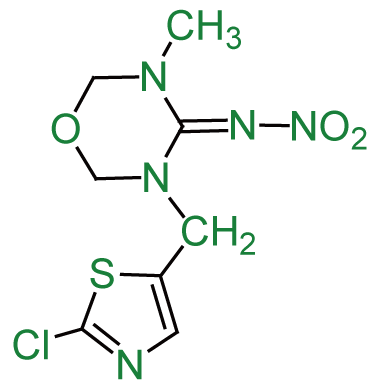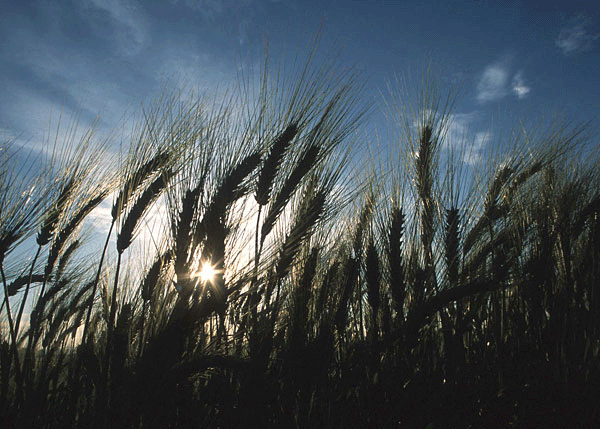- Abamectin
- Acetamiprid
- Alpha-cypermethrin
- Amitraz
- Azamethiphos
- Bifenthrin
- Bacillus thuringiensis
- Carbosulfan
- Chlorfenapyr
- Chlorfluazuron
- Chlorpyfifos
- Clothianidin
- Cypermethrin
- Cyphenothrin
- Clofentezine
- Cyromazine
- Deltamethrin
- Diafenthiuron
- Diazinon
- Diflubenzuron
- Emamectin Benzoate
- Empenthrin
- Fipronil
- Flufenoxuron
- Fenazaquin
- Hexythiazox
- Hydramethylnon
- Imidacloprid
- Indoxacarb
- Lambda-cyhalothrin
- Lufenuron
- Malathion
- Methomyl
- Nitenpyram
- Novaluron
- Permethrin
- Propargite
- Profenofos
- Pymetrozine
- Pyriproxyfen
- Sulfluramid
- Teflubenzuron
- Tetramethrin
- Thiamethoxam
- Thiodicarb
- Trichlorfon
- Triflumuron
Thiamethoxam
Other Name:3-[(2-chloro-5-thiazolyl)methyl]tetrahydro-5-methyl-N-nitro-4H-1,3,5-oxadiazin-4-imine  ;
;
CAS Number: [153719-23-4]
Molecular Formula: C8H10ClN5O3S
Thiamethoxam is a broad-spectrum, systemic insecticide, which means it is absorbed quickly by plants and transported to all of its parts, including pollen, where it acts to deter insect feeding. An insect can absorb it in its stomach after feeding, or through direct contact, including through its tracheal system. The compound gets in the way of information transfer between nerve cells by interfering with nicotinic acetylcholine receptors in the central nervous system, and eventually paralyzes the muscles of the insects
Thiamethoxam is a broad-spectrum insecticide that effectively controls insects. Thiamethoxam is synthetic in origin, being a second generation neonicotinoid compound belonging to the chemical subclass the thianicotinyls. Thiamethoxam can be applied as a foliar application, a soil treatment and a seed treatment. Thiamethoxam is rapidly taken up by the plant, with excellent translaminar movement, and is transported acropetally in the xylem.
Thiamethoxam effectively controls sucking and chewing insects, including aphids, whitefly, thrips, ricehoppers, ricebugs, mealybugs, white grubs, potato beetles, flea beetles, wireworms, ground beetles, leaf miners and some lepidopterous species. The effect of thiamethoxam on the target organisms is due to exposure to the chemical on contact, within the stomach contents and also systemically. Thiamethoxam is approved in the United Kingdom for use on potatoes, apples, pears and ornamental house plants. As a seed treatment, in combination with fludioxonil and metalaxyl-M, thiamethoxam not only controls insects, but also resulting in increased yield. Seed treatment is approved for fodder rape, mustard, sugar beet and oilseed rape. Thiamethoxam is mainly sold as 25% WG (Water dispersable Granules), 35% SC (Soluble Concentrate) and 70% WS(Water dispersal powder as Slurry for seed treatments).
APPLICATIONS
Biochemistry
Agonist of the nicotinic acetylcholine receptor, affecting the synapses in the insect central nervous system.
Mode of action
Insecticide with contact, stomach and systemic activity. Rapidly taken up into the plant and transported acropetally in the xylem.
Uses
For control of aphids, whitefly, thrips, ricehoppers, ricebugs, mealybugs, white grubs, Colorado potato beetle, flea beetles, wireworms, ground beetles, leaf miners and some lepidopterous species, at application rates from 10 to 200 g/ha (R. Senn et al., loc. cit.). Major crops for foliar and soil treatments are cole crops, leafy and fruity vegetables, potatoes, rice, cotton, deciduous fruit, citrus, tobacco and soya beans; for seed treatment use, maize, sorghum, cereals, sugar beet, oilseed rape, cotton, peas, beans, sunflowers, rice and potatoes. Also for control of flies in animal and public health, such as Musca domestica, Fannia canicularis, and Drosophila spp.
Formulation types FS; GR; SC; WG; WS.
Our Technical Material (TC) of Thiamethoxam have the specification as below:
| Items | Specification |
|---|---|
| Appearance | Light yellowish crystalline powder |
| Content (by HPLC) | 95% min. |
| Water | 0.5% max. |
| Insoluble Matter in DMF | 0.2% max. |
| Insoluble Matter in Acetone | 0.2% max. |
| Acidity (As H2SO4) | 0.3% max. |
GHS complaint Safety Data Sheet (SDS) for commercial product of Thiamethoxam is available uopn requested.
